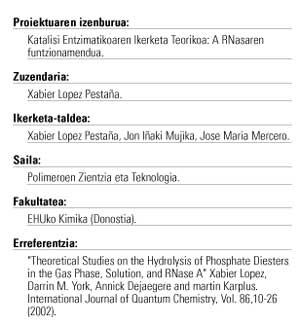Continuous analysis of ribonuclease A
Xabier López of the Faculty of Chemistry of the UPV has been immersed in a project for 5 years. He has recently returned to the faculty of Chemistry in San Sebastián to continue with the research. We have had the opportunity to talk with him and his former teacher Jesus Ugalde about this project that addresses the topic of proteins.
Proteins, enzymes, are the catalysts of reactions. Its function as a reaction agent is directly related to diseases. Therefore, understanding how they work, it is possible to avoid or stop these diseases.

Xabier works with the enzyme A ribonuclease (A RNasa). The function of this important enzyme is to break the air chain. The transmitter of genetic information, RNA, is divided into nucleotides once used. For this purpose, A RNasa cuts the air chain.
Although the structure of ribonuclease A was known 30 years ago, they have not yet found the key to its operation. On that path the discovery of the human genome has been a step, but the following is to know what happens with this sequence. “From the secuence to the consecuence”, from the sequence to the conclusion.
In the case of A RNasa is still known the crystalline structure, the static structure. ’We don’t know how it moves, nor what structure it has when it works’, says Xabier.
Methods of study
All these proteins are analyzed by spectroscopy or NMR method. The well-known NMR method only serves for the study of small proteins. X-ray diffraction spectroscopy can only study the crystal structure. In order to know what is the behavior of moving proteins, a very fast spectroscopy would be necessary, capable of taking a large number of photos in a short time. Unfortunately, despite the advances made, this technique is not developed for the moment.
This process, which begins experimentally, analyzes all the steps of the reaction, considering the geometry and energy levels of proteins. On the other hand, theoretically, the equation of energy is proposed according to the possible ways of reaction. As it is a process that is not perfect, several assumptions are made and in the end it is checked whether or not these properties have been fulfilled. Thus, the results of the experimental and theoretical part coincide in a “feedback”.
This project, which combines chemical, physical and computer instinct, will undoubtedly have a long follow-up.






